I have this 3d plot that I draw in cran R
rb = rep(seq(0.1, 1, 0.1), 10)
ro = sort(rb)
lods = runif(100) #create a random LOD score
library(scatterplot3d)
lodsplot<- scatterplot3d(rb, ro, lods)
I found the maximum of the LOD score using max(lods) and thus, find the respective rb and ro. Now, I want to find the 95% CI of rb and ro. Assume max(lods) = 0.8 and respective rb and ro are 0.2 and 0.3, I thought of drawing a plane using:
lodsplot$plane3d(c(0.2, 0.3, 0.8))
and then find points above the plane (which I don't know how to do). Am I thinking correctly? Thank you!
Note:
If I just do a 2d plot, this is how i would do it:
plot(rb, lods, type = "l)
which(lods == max(lods))
limit = max(lods) - 1.92
abline(h = limit)
#Find intersect points:
above <- lr > limit
intersect.points <- which(diff(above) != 0)
